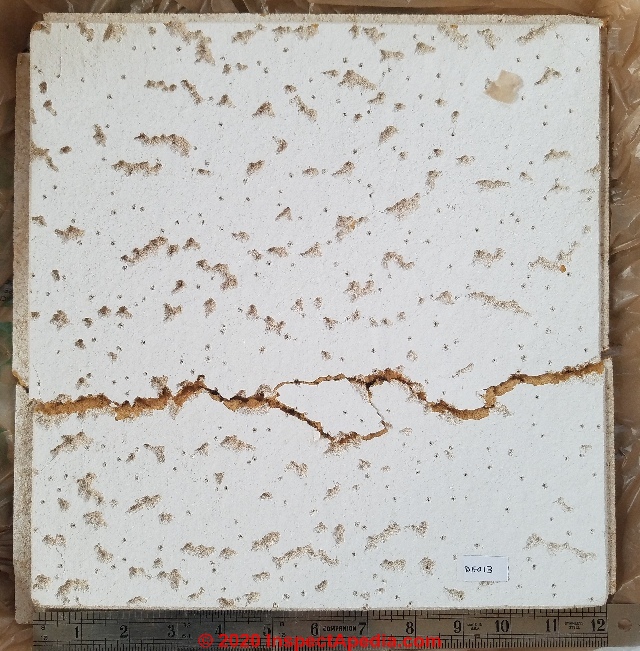

#Asbestos acoustic ceiling tiles free
If you or a loved one were exposed to asbestos-containing acoustical ceiling tiles and have been diagnosed with mesothelioma or lung cancer, please contact us for a free and confidential case evaluation. The absence of a label does not mean the material is asbestos free. The cleanup process created additional asbestos-containing dust that workers inhaled. After a ceiling grid was installed, scrap pieces were disposed of and the floor was swept. This process also emitted asbestos dust and fibers into the breathing area of those who cut and applied the acoustical ceiling tile, as well as to those who worked in the vicinity where this work was conducted, including carpenters and electricians. Similarly, workers used a jab saw to cut an opening in the tiles to allow for lighting fixtures or ventilation outlets. Simply handling acoustical ceiling tiles produced asbestos-containing dust, and cutting or kerfing the ceiling tiles created a tremendous amount of asbestos dust that workers inhaled. Asbestos fibers were used in some acoustic asbestos ceiling tiles. Laborers, including carpenters, also kerfed (groove cut) tile so that ceiling tiles could properly fit into a spline or supporting members of a ceiling suspension system. The tiles in your home most likely to contain asbestos are ceiling and flooring tiles. Regardless of the system employed, it was often necessary for laborers to cut the ceiling tiles to fit around irregular parts of the ceiling. Some asbestos-containing ceiling tiles were merely stapled or nailed into the underside of the floor above, and others were hung by a system of interlocking panels. Acoustical ceiling tiles were typically suspended from wires or placed into a metal grid T-bar system that dropped about one foot below the underside of a ceiling. How they were attached is not a key point.

The two keys for your situation are (1) acoustic ceiling tile and (2) in an old house. Typically, acoustical ceiling tiles were used in order to conceal HVAC ducts, electrical wires and plumbing. I’m not familiar with any acoustic ceiling tile (acoustic meaning approximately 12 x 12', which is what they were called in the industry), manufactured prior to 1979 that did not have asbestos in it. Manufacturers of asbestos-containing ceiling tiles included Armstrong, Celotex, USG and Conwed (LoTone). Incorporating asbestos into ceiling tiles provided fire resistance and sound absorption. Prior to the late 1970s, most acoustical ceiling tiles contained asbestos. How do I find out more information?įor more information about asbestos, contact the Asbestos Program at MDH through the internet or by telephone at (651) 201-4620.Acoustical (drop or suspended) ceiling tiles are commonly found in commercial and residential buildings. What if the ceiling tiles or panels are being moved for maintenance purposes?Ĭeiling tiles or panels in a facility being moved to perform maintenance work on or around a mechanical system or machinery is still considered regulated as ARW by MDH under the same conditions listed above. Armstrong Ceiling Tiles 2x4 Ceiling Tiles - Acoustic Ceilings for Suspended Ceiling. * this ACM, which has accumulated above the tiles or panels to be moved, would need to be estimated in cubic feet. Asbestos Cement Armstrong Ceiling Tile 50/ Square Feet Get Latest. all the work practices in Minnesota Rules, parts 4620.3000 to 4620.3598 must be followed.the work must be performed by a licensed asbestos abatement contractor, and.If the project is regulated by MDH, then: the total amount of all friable ACM to be disturbed during the project or in the facility during the calendar year is greater than 260 linear feet, 160 square feet or 35 cubic feet.the ceiling tiles or panels do not contain asbestos, but friable asbestos-containing material (ACM) has accumulated on top of them from the degradation of other ACM such as fireproofing or pipe insulation above the tiles or panels.*.the ceiling tiles or panels contain more than one percent asbestos or.is regulated as asbestos-related work (ARW) by the Minnesota Department of Health (MDH) when: To identify asbestos ceiling tiles, you can also check the stamps or statements on the tiles, their packaging, or the installation records. Removing friable ceiling tiles or panels from a facility or moving them for installation of equipment, cables, etc. Removing or Moving Ceiling Tiles and Panelsĭoes MDH regulate removing or moving ceiling tiles or panels for equipment or cable installation?


 0 kommentar(er)
0 kommentar(er)
